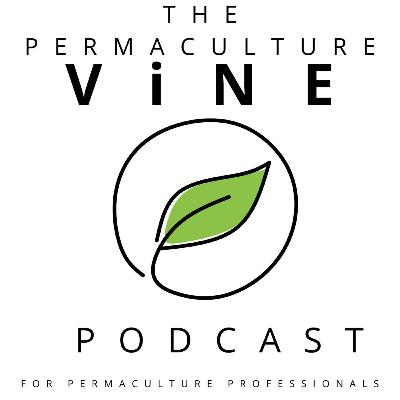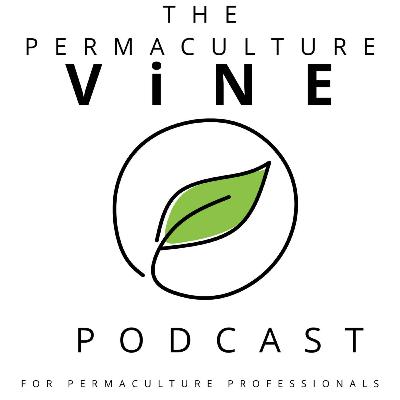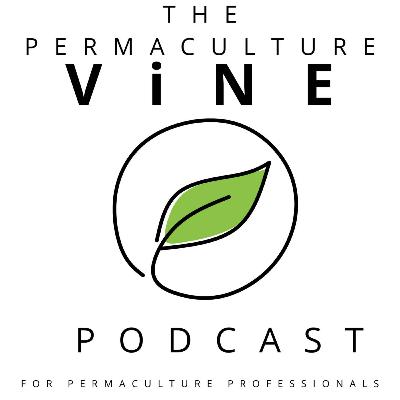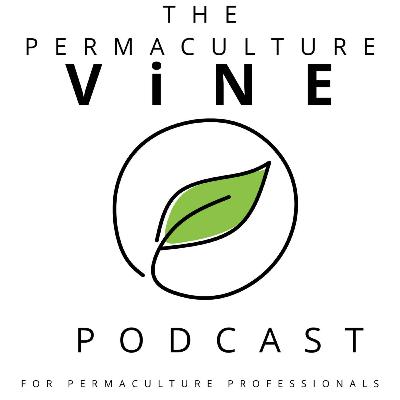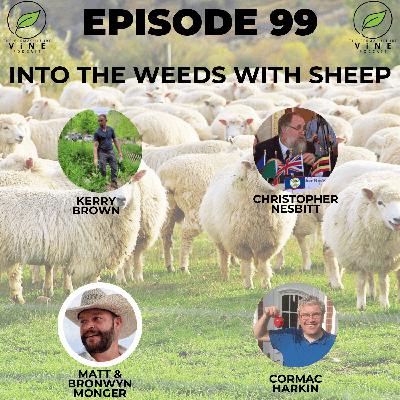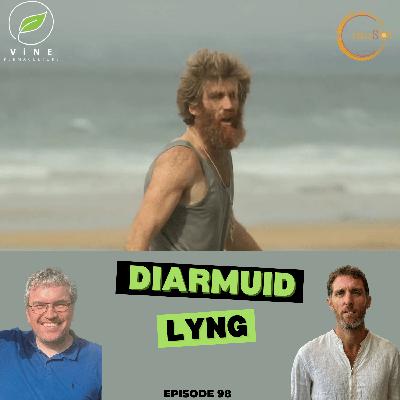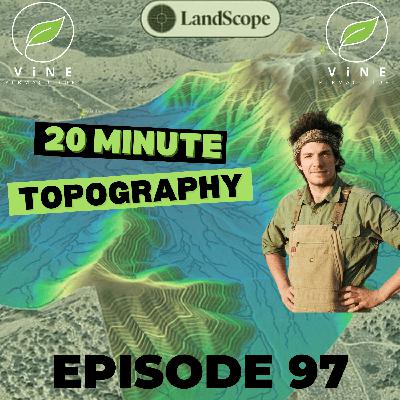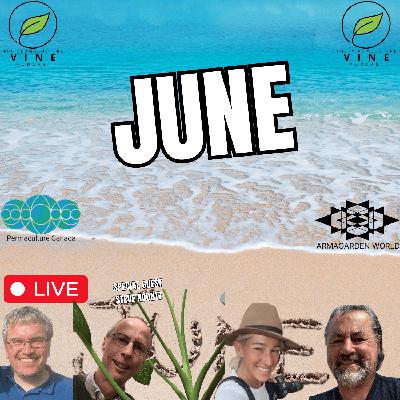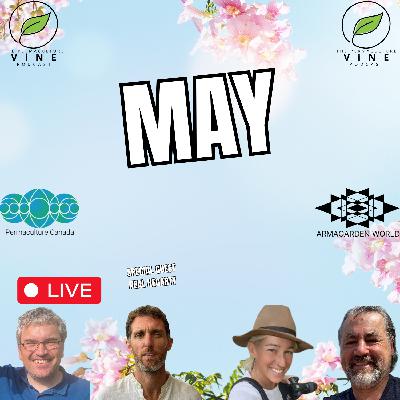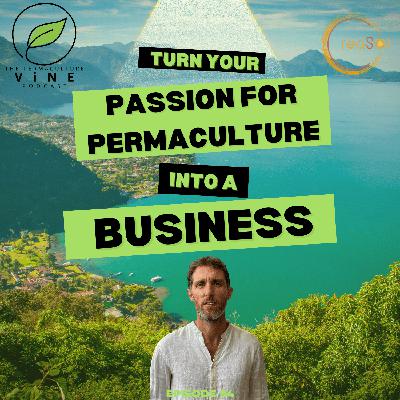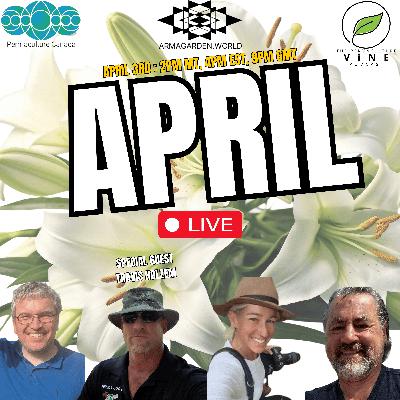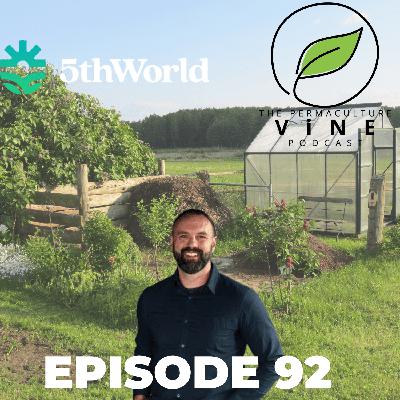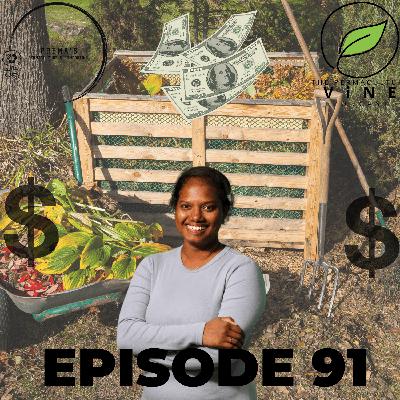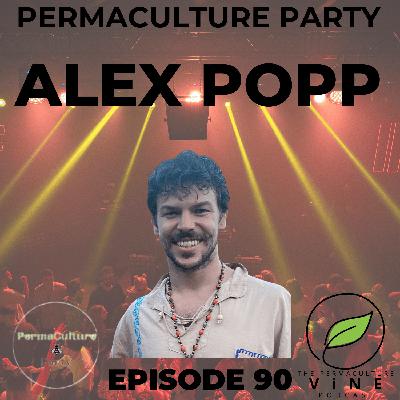Discover The Permaculture Vine
The Permaculture Vine

The Permaculture Vine
Author: Cormac - The Permaculture Vine
Subscribed: 12Played: 74Subscribe
Share
© Cormac Harkin
Description
We interview permaculture designers, practitioners and educators on how they discovered permaculture, and how they are doing in their permaculture careers and businesses.
cormacharkin.substack.com
cormacharkin.substack.com
105 Episodes
Reverse
Join The Permaculture Vine free Skool community for connection and learning: https://www.skool.com/vine-permaculture-7207/aboutIn Episode 110 of the Permaculture Vine podcast Cormac, Lindsay and Graham chat about their harvest yields and upcoming design work while addressing a growing concern about artificial intelligence in their field.Physical Labour and Tree RestorationGraham’s autumn has cantered on an intensive tree replanting project at a solar farm adjacent to his Michigan property. The job involves correcting improper installation work—1,122 trees were planted with metal cages and burlap left intact around root balls, causing widespread tree death. His team has been working 13-14 hour days removing dead trees, digging new holes, and properly installing replacements. By the recording date, 350 trees were planted and tagged, with Graham noting the physical challenge of keeping pace with Azure, Lindsay’s 36-year-old partner who’s been operating the heavy machinery.The project illustrates a common problem in large-scale installations: contractors unfamiliar with proper tree planting techniques can create more problems than they solve. The burlap and wire cages, meant to be temporary supports, prevented root expansion and essentially strangled the trees.Harvest OutcomesGraham reported exceptional yields this year, attributing much of the success to having additional help on the property. His harvest included first-time production from aronia berries, honey berries, and golden raspberries—all bearing fruit in their first year in the ground. His asparagus bed, planted with 1,000 crowns, exceeded expectations by producing thumb-thick spears in its second year rather than the pencil-thin stalks typically expected. The plants even produced an unusual fall flush following late-season rain and fertilization.Other significant harvests included several hundred pounds of garlic, a couple hundred pounds of potatoes, 40-50 butternut squash, and abundant fruit from seven-year-old cherry trees. Graham’s experiment with Cabernet Sauvignon wine grapes succeeded despite conventional wisdom that Michigan’s climate wouldn’t provide sufficient heat for proper flavour development.Lindsay’s harvest was constrained by an impending move—her parents are selling their property in spring, so she and Azure excavated her entire food forest and potted the plants. She processed beets into kraut and preserved garlic in vodka for tincture. With her daughter moving out and plans to spend extended time in Central America, she’s not planting for next season.Cormac in Ireland reported a “mast year”—a term for exceptional nut production—with abundant chestnuts and apples, though his pear harvest came late.The Winter Design WindowWinter represents prime design season for northern permaculture practitioners. Graham explained that from mid-November through mid-April, outdoor work essentially stops in Michigan as the ground freezes two to three feet deep. This period allows designers to focus on client projects, planning, and indoor work.Current design prospects include two campus health clinics seeking to produce food for their communities, potential projects in the US Virgin Islands and Bahamas, and continued work on intentional community development. Lindsay is developing business structures that bridge traditional corporate models with private membership associations, researching share structures and sociocracy for community projects.She’s also exploring new technology for design presentation, particularly VR and 3D modelling using LIDAR mapping. The goal is to show clients not just what a design looks like initially, but how it will develop over time—a challenge Graham identified as one of the hardest aspects of design communication.The AI ProblemThe conversation took a pointed turn when discussing artificial intelligence in permaculture. Cormac raised concerns about AI-generated content appearing in permaculture circles, citing examples of guilds showing apples and strawberries fruiting simultaneously—an impossibility since strawberries fruit in early season and apples late. He also encountered Facebook groups using AI bots to stimulate conversations, essentially training AI systems on human responses without participants’ knowledge.Graham was direct: “I’m sorry, I don’t want to teach a robot how to do my job anymore. I want to keep what I enjoy for myself and my friends in permaculture.”Lindsay added that AI imagery in project presentations immediately raises red flags for her—it signals conceptual work that may never materialize rather than grounded, practical plans. She’s positioning her upcoming permaculture design certification course as explicitly “written by a human” to distinguish it from AI-generated content.The group agreed that AI has limited appropriate uses—Graham finds it helpful for meeting notes and action item lists—but its application to design work removes the human element that’s central to permaculture’s second ethic: people care.Design Contact InformationWinter design services are available through Permaculture Canada (permaculturecanada.world), Permaculture Adventures Michigan (permacultureadventuresmi.com), and through Cormac’s strategy sessions for clients seeking guidance on whether they need consultations or full designs. Graham and Lindsay work internationally with no geographical limitations beyond Antarctica, while Cormac focuses on in-person designs within Ireland and client liaison work for international projects.Buy a design from Permaculture Canada:https://permaculturecanada.world/shop/?ref=etcvdgzjBook a Free 30 minute strategy call with Cormac:https://zcal.co/vinepermaculture/30min Get full access to Cormac Harkin at cormacharkin.substack.com/subscribe
The Unexpected Path to PermacultureNot every permaculture journey starts in a garden. For Marina and Alexander, founders of Thistle Thorne Permaculture, it began in the sterile halls of medicine—with a growing sense that something was missing.As Marina recalls, “After we were already medical doctors, we were unsatisfied with our career. And we wanted something that we could really dedicate our lives to that was meaningful.”Alexander’s search for meaning led him down an unexpected path. “I was searching about health and the systematic or universal aspects of health. And I came across about these discussions and research about soil health and human health.”This curiosity introduced him to Masanobu Fukuoka, the Japanese farmer and philosopher whose revolutionary “One Straw Revolution” challenged everything he thought he knew about agriculture.“I read his books and I was amazed. And I was wondering, like, that’s amazing. How can we go? How can I do it?”Fukuoka’s work opened the door, but it was Bill Mollison’s comprehensive permaculture texts that provided the roadmap. “When I researched further, I found Bill Mollison’s book. Because Bill Mollison, especially in introduction in Permaculture 2 and 1, he talks a lot about Fukuoka,” Alexander explains.Soon they were watching recordings from 2002: “There is an old PDC course recorded by Bill Mollison and Geoff Lawton. Yeah, with a young Geoff Lawton. And we did this course first.”The couple made a decision that would change everything: they would leave medicine behind and become permaculturists.Education and RealityMarina and Alexander enrolled in Geoff Lawton’s year-long online PDC course. While they found it valuable, they quickly realized something crucial about the limitations of theoretical learning.“We did the online PDC one year course. It was very, very good. Like we learned a lot,” Marina shares. “Maybe we had another expectation. We thought it would be more practical, but it’s very theoretical and very based on the book.”She continues, “We really think that you can only understand the important points when you really need theory in daily life. So we really had clear to us that we should start something so that we could really learn.”This realization led them to Austria for a three-month internship at what they believed would be a permaculture farm. The experience proved eye-opening—but not in the way they expected.“Actually when we came there, it was really organic, but it was not permaculture anymore,” Marina explains. “The owners, they did a permaculture course a long time ago and they didn’t implement actually many, many permaculture principles.”Fresh from their PDC training, Marina and Alexander could see countless opportunities. “As the course, the PDC was so fresh in our heads, we could see so many opportunities to implement permaculture systems.”Marina reflects on the experience: “They had so much work that in our vision was unnecessary and they could really implement systems that would work for itself like flywheels.”The experience taught them a valuable lesson about resistance to change in traditional farming communities. As Alexander observed, “We learned that people from the countryside, they are very rooted in old ways. So many times they have difficulty to break free from these old patterns.”Rather than seeing this as a setback, the couple recognized an opportunity. “Then we decided, OK, maybe we need to do our own stuff. Like we don’t have to wait for someone to do it so that we can learn. We can just start by ourselves,” Marina concludes.The Backyard RevolutionAfter their internship, Marina and Alexander faced a practical question. “That takes us to a very important question, like how do you afford life while you change careers and plans,” Alexander notes. “Of course, we had like savings from our previous life and we had a plan, like if we needed to, we would search for a part-time job.”More importantly, they had to decide their focus. “We were thinking about how do we want to go about permaculture,” Alexander recalls, listing various possibilities from conservation to large-scale farming.“But we decided to go about the backyard,” he states simply.Why backyards? “We based on Bill Mollison and Geoff Lotto as well, they say basically that backyards are a golden opportunity. Like they start with small trials and expand.”The couple had learned about research supporting this approach. As Alexander explains, “There is this research about how productive a site is. And they found out that between, I think, 100 meters and 5,000... they say that’s the most productive size of a farm because you can have the input, the human input, to create the interaction, interactions between the elements, to multiply the yield.”Marina adds context about their philosophy: “Like we see the garden as an ecology that sustains itself and it’s like a modular element. And if you think of a farm, like many modular elements together that are all self-sustaining, you can make like a wonderful project.”They even reference Fukuoka’s claims: “Fukuoka said in his book that 200 square meters is enough to feed one person,” though Alexander notes, “it’s a very specific system, like with rice and like this Japanese style.”For over two years now, they’ve been practicing what they preach. Marina emphasizes this point: “Since the beginning we we knew that we had to do it for ourselves so that we know that it works and that we can tell how people can do this. And then that’s why we like since the beginning since we moved here we found a place to garden here and we did our own garden.”She continues: “This is already like more than two years that we’ve been gardening for ourselves, raising all the seedlings, making all the compost, all the mulch, all the design, like planting the trees, perennials, everything that we talk about in our newsletter, we do for ourselves.”“Our own little small gardens have revolutionized our lives,” Marina reflects.Building Community on X (Twitter)The couple chose to build their platform on X (formerly Twitter), where they actively share their gardening experiences and permaculture insights at @ThistleThorn_TT.“For example, now we have as our social media, we’re a lot on Twitter and we post a lot about our own gardens also there,” Marina explains. “This is our case study for all that we talk about in our newsletter.”Looking ahead, Marina shares their expansion plans: “We are really planning soon to start a YouTube channel. We have a project for next year to implement a new home garden for someone we know here in the region so we are really planning to start a Youtube channel to show how we will start from point zero like how to start a backyard.”The Newsletter: Recipes for RegenerationAt the heart of their work is the Thistle Thorne Permaculture newsletter, where they share practical, step-by-step guidance.“We start the newsletter... as a meta for a business model, how to reach people, how to serve people,” Alexander explains.The approach is deliberately practical. “We decided to start a newsletter to talk about, to write and show people how to do it in an easy way, pragmatic way, like a recipe. Like you have a base recipe that you can try and it’s proven because someone did it. And based on that, you learn the principles and iterate on top of that, like an experiment.”Their teaching philosophy emerged from gaps they discovered in their own learning. Alexander shares an important realization: “We noticed that in Bill Mollison’s book, I think there are some stuff that for them it’s obvious... And for them, it’s very obvious. But for someone who comes from the city, it’s not obvious.”Marina illustrates with examples: “Like, how do I pick up a small plant? Or how do I harvest plants? How do I prune a tree or... How do I mulch? Like, okay, so I just cut some grass and is that mulch? Like, what should I do?”Alexander uses an analogy to drive the point home: “That is, like, very complete. Very nice. Just like this, like, basic... Like, basic in the sense, like really the first steps... Like for example, when you learn how to drive and, oh, turn on the car, like, oh, but how, how do you do that?”Living in Austria’s Dairy CountryMarina and Alexander settled in Vorarlberg, Austria’s westernmost state. “We now live are based in Austria. We live here,” they explain in their introduction.The region has a unique agricultural character. “We live in the state of Vorarlberg. This is in the region where it’s share the limits with Switzerland, Germany and Italy. It’s the West side. It’s a mostly rural area with a lot of milk production and cheese,” Alexander describes.Marina adds with a laugh: “It’s funny here because they have a really strong milk culture and cheese culture. And grass culture. And grass, yeah, of course. But I think like 90% of the production, like food production is milk and cheese. Here. And 10% is everything else.”While this monoculture mindset presents challenges, it also offers unexpected benefits. “We were really looking for a healthy environment for ourselves and for our gardens. And this is a place we really can’t say anything about because water is amazing. We drink tap water, it’s the best water we’ve ever had. The air is amazing,” Marina enthuses.Alexander explains why: “They really don’t use pesticides because of the cows. Of course, they fertilize the grass and so, but with manure.”The region’s dairy focus has also sparked innovative thinking. Alexander shares an interesting statistic: “I think 90% or 99% of the cheese produce in Europe comes from milk, from cows, of course, that are given silage... Only 10% or 1% of the milk is from... grass fed... And here, from this 10 or 1% of this cheese from Europe, 90% come from here.”This creates an opportunity they’re excited about: “We were thinking about like building a pond, a pond, which like this nitrogen rich water would come and create azola and that could be used to make compost or like anything wit
In this episode of the Permaculture Vine Podcast, host Cormac Harkin sits down with Grant Payne, the innovative mind behind Christine Acre Farms. Grant shares his inspiring journey from a high school graduate to a passionate farmer embracing permaculture principles. Discover how he creatively utilizes IBC containers for sustainable farming, balances commercial and personal agricultural goals, and navigates the challenges of starting a farm from scratch. Tune in for a deep dive into the world of permaculture, resilience, and the future of sustainable farming. Get full access to Cormac Harkin at cormacharkin.substack.com/subscribe
Join The Permaculture Vine free Skool community for connection and learning: https://www.skool.com/vine-permaculture-7207/aboutwww.cultural-emergence.comIn this episode of the Permaculture Vine podcast, host Cormac Harkin chats with Looby Macnamara, renowned permaculture teacher, author, and co-founder of Applewood Permaculture Centre. Looby shares her inspiring journey from discovering permaculture as a student to becoming one of the UK’s most influential teachers, authors, and cultural change facilitators.We explore her pioneering work on People and Permaculture, the development of the Design Web, and her latest book Design Adventures. Looby also introduces Cultural Emergence, a framework for creating thriving, regenerative cultures that go far beyond gardening and land-based design. This conversation is packed with wisdom for anyone seeking to apply permaculture to their lives, communities, and the wider world.Key Takeaways* How Looby discovered permaculture and her path to becoming a teacher.* The importance of teaching styles, collaboration, and community in permaculture learning.* Looby’s journey in writing People and Permaculture, Seven Ways to Think Differently, and Design Adventures.* The origins and purpose of Cultural Emergence.* Practical advice for finding and caring for land with permaculture principles.* Why permaculture is more than gardening—it’s a way of redesigning our culture.Chapters00:00 – Introduction01:05 – Looby’s first encounter with permaculture02:39 – Discovering community, creativity, and fun in permaculture06:00 – Becoming a permaculture teacher10:00 – Teacher training and empowering new educators12:39 – Developing Applewood Permaculture Centre20:00 – Advice for finding land with permaculture principles24:28 – Looby’s book writing journey26:00 – People and Permaculture & the Design Web27:22 – Seven Ways to Think Differently28:26 – From Social Permaculture to Cultural Emergence30:00 – Design Adventures and designing as an ongoing practice33:28 – Designing for people and culture35:00 – Making permaculture mainstream and accessible39:02 – Why permaculture is more than gardening40:00 – Cultural Emergence and shifting culture44:04 – Strengthening networks and collective wisdom46:02 – Final reflections and invitation to start your own design adventureLooby MacnamaraLooby Macnamara is the co-founder of the global Cultural Emergence movement. She is an author, designer, gardener, song leader, mother, and artist. She is the author of five influential books: Design Adventures, People & Permaculture, 7 Ways to Think Differently, Cultural Emergence, and Strands of Infinity, and creator of the CEED -Cultural Emergence Empowerment & Design card deck.Looby is a visionary thought leader who inspires thousands with her creative approaches to regenerative change. People & Permaculture is the first book globally to translate permaculture to people-based systems. Her latest toolkit Cultural Emergence brings together innovative models for behavioural and cultural change, weaving together systems thinking, cultural awareness, design, and nature connection.Looby runs Applewood Permaculture Centre in Herefordshire, UK, with her partner Chris Evans, where they facilitate courses and demonstrate both land and people permaculture.Looby is an active member of the Permaculture Association Britain and has been chairperson and trustee. She is currently a senior tutor. Looby is on the expert panel for the design council. She is one of the founding partners of the international Mother Nature project.Sign up to her newsletter to get the Cultural Emergence colouring book for free.For signed copies all Looby’s books, resources, global community and online and in-person courses see www.cultural-emrgence.com Get full access to Cormac Harkin at cormacharkin.substack.com/subscribe
Join The Permaculture Vine free Skool community for connection and learning: https://www.skool.com/vine-permaculture-7207/aboutIn this episode of the Permaculture Vine podcast, host Cormac Harkin interviews Brandon Cooper, a permaculture designer and homesteader. They discuss Brandon's journey into permaculture, his experiences living off-grid, and the challenges he faced while transitioning to a landscaping business. Brandon shares insights on homesteading, community involvement, and the importance of sustainable practices. He also offers advice for newcomers to homesteading and discusses his future plans for community development and larger-scale projects.]https://coopermountaincontracting.com/https://www.youtube.com/@MybackyardpantryTakeaways* Brandon has been on a transformative journey in permaculture.* Living off-grid provided valuable life lessons.* Permaculture design courses are crucial for practical knowledge.* Mistakes in landscaping can be costly and discouraging.* Homesteading is about producing rather than consuming.* Community involvement enhances food production.* Understanding permaculture basics is essential for success.* Planning and budgeting are key to effective homesteading.* Brandon aims to influence larger community projects.* Interpersonal relationships are vital in intentional communities.Chapters* 00:00 Introduction to the Permaculture Vine Podcast* 07:06 Permaculture Design Course Insights* 16:14 Building a Landscaping Business* 23:43 Creating a Food Forest and Community Impact* 28:54 Sharing Surplus and Community Engagement* 36:07 Business Goals and Community Development* 41:12 Advice for New Homesteaders Get full access to Cormac Harkin at cormacharkin.substack.com/subscribe
In episode 104 of The Permaculture Vine Podcast, inside the Cresol Mastermind Group, Cormac Harkin chats with Neal Hegarty and his siblings Aron and Sorcha from Candldelit Tales. They talk about:* Land use in Irish Mythology* Storytelling from a Cultural Perspective* The Importance of Storytelling Get full access to Cormac Harkin at cormacharkin.substack.com/subscribe
Join our free Skool community for connection and learning: https://www.skool.com/vine-permaculture-7207/aboutIn this episode of The Permaculture Vine Podcast, Cormac Harkin sat down with Steve Kuntz to explore a fascinating side of food production that goes beyond the garden bed—indoor, soilless growing systems. Steve has been working with hydroponics, aeroponics, and especially tower gardens for over a decade, helping schools, families, and communities reconnect with how food is grown.From Grandma’s Cactus to Indoor LettuceSteve’s love of gardening started young—his first plant was a cactus given to him by his grandmother. Years later, in 2012, he was introduced to the tower garden, a vertical aeroponic growing system. The experience of cutting fresh lettuce in the middle of a snowy Indiana winter was a turning point, sparking a passion for indoor gardening.How Tower Gardens WorkTower gardens use water, nutrients, and light—no soil required. A pump circulates nutrient-rich water to plant roots that are suspended in air. This makes them compact, efficient, and easy to manage indoors or outdoors. Steve explained the differences between:* Hydroponics: roots grow in water.* Aeroponics: roots are misted in air.* Aquaponics: combines fish and plants in a symbiotic system.For beginners, Steve recommends smaller countertop systems like the LetPot Mini (about $60), which can grow herbs or lettuce in a kitchen or dorm room.Bringing Growing Systems Into SchoolsIn 2015, Steve began introducing tower gardens into schools. With grant funding, his local district installed 15 units. These have become powerful educational tools, teaching children not only how food grows, but also reinforcing science, math, and healthy eating.Steve shared stories of fifth and sixth graders teaching younger students about nutrition—complete with a salad party featuring their own harvest. Partnerships with Purdue University and community wellness educators have expanded the program across Indiana and beyond.Benefits and ChallengesThe systems are compact (about three square feet for a 28-plant tower) and work year-round. While some sceptics worry about taste or authenticity compared to soil-grown produce, Steve says one bite usually changes their minds. The biggest challenges? Occasional pump clogs, algae build-up, and the need to maintain proper light and water cycles.Indoor Growing vs. Large-Scale FarmsCormac also asked Steve about the scalability of indoor farms. While some large warehouse projects have struggled with energy costs, Steve sees promise in rooftop gardens, greenhouses, and small-scale community models. For him, the priority remains accessibility and education rather than industrial farming.Seeds of the FutureBeyond tower gardens, Steve is also experimenting with permaculture ideas. Recently, he planted peach trees around his retirement community and has been slowly nudging neighbours toward replacing lawns with wildflowers and food crops. His story about growing a giant sequoia seedling—before donating it to a school greenhouse—shows his passion for the magic of seeds and growth.Steve’s Advice: Just Start GrowingSteve’s closing message is simple but powerful: just start. Whether it’s a pot of herbs on your windowsill, a tower garden in your kitchen, or seeds in the soil, gardening is about learning, experimenting, and enjoying the process.Learn More* Steve’s book: Growing to Teach (available on Amazon)* Website: keepitwatered.comIndoor gardening may not replace soil and sunshine, but as Steve shows, it’s a brilliant way to grow food anywhere, anytime—and to inspire the next generation. Get full access to Cormac Harkin at cormacharkin.substack.com/subscribe
Join our free Skool community for connection and learning: https://www.skool.com/vine-permaculture-7207/aboutIn this episode, Cormac sits down with Dave Spicer to explore his journey through permaculture, earthworks, and design. From his early experiences training with Bill Mollison and Geoff Lawton to years of practical work on farms and landscapes, Dave shares hard-won lessons on water, access, surveying, and the realities of broadacre design.This conversation has insights for beginner and professional designers alike — from starting small with “baby steps, baby mistakes” to scaling up into large-scale projects that truly shape the land.Key Points from the Conversation:* Journey into Permaculture: Dave discovered permaculture after leaving school early. He was inspired by Bill Mollison's "Global Gardener" video and took a PDC with Mollison in Tasmania in 1999. He then gained practical experience working with Geoff Lawton at Tagari Farm.* Philosophy and Approach:* Start Small: He emphasizes "baby steps, baby mistakes," advocating for people to begin with small projects like a home garden to learn through observation and interaction.* Design to Reality: His design philosophy focuses on simplicity and practicality. He prioritizes creating a "basic mainframe" cantered on Water, Access, and Structure Position. He argues this creates the "skeleton" of the design, upon which the rest evolves.* Water is Fundamental: The primary element of any design must be water harvesting and retention. He stresses observing where water comes from (e.g., roads as catchments) and how to slow it, sink it, and store it in the landscape.* Access is Interaction: A major theme is that "good access is good interaction." If a site is difficult to access, people won't interact with it, observe it, or learn from it. This is why he now prefers terraces over swales on large scales, as they provide better access for people, animals, and machinery.* Observation is Key: The most important skill for a designer is developed through patient observation of one's own site.* Advice for New Designers:* Begin with small-scale projects and make mistakes there.* Focus on water first in any design.* To move into larger-scale/broadacre design, learn surveying (e.g., using a laser level). Understanding how to map contours on the actual land is crucial because maps are often inaccurate.* If doing earthworks, find and learn from an experienced machine operator.* Broader Views:* He promotes the "lifeboat" concept: creating resilient, productive systems (food, water, trees) around homes for sanity, real food, and demonstration purposes. He connects this to practices like Japanese "forest bathing," highlighting the mental and physical health benefits of engaging with nature.* Action and Demonstration: The most powerful tool is action—demonstrating what works on your own land is more effective than just talking about it.What resonated most with you from this episode? Drop a comment below!Where to Find Dave:* Website: www.docspice.life* Instagram: @docspice_permaculture* Tiktok: https://www.tiktok.com/@docspice_permaculture?lang=enChapters00:00 – Introduction02:00 – How Dave discovered permaculture04:20 – Training with Bill Mollison & Geoff Lawton07:00 – From PDC to practical experience10:15 – Building confidence as a designer13:20 – Why water is the foundation of good design18:00 – Moving from urban to broadacre projects22:00 – Swales vs. terraces & lessons from earthworks30:00 – Designing to reality, not just pretty pictures36:00 – Surveying, mapping & reading the land44:30 – Learning resources & next steps52:00 – Final thoughts & advice for new designers Get full access to Cormac Harkin at cormacharkin.substack.com/subscribe
New Episode: From Fear to AbundanceLast week I had a fantastic conversation on the Permaculture Vine podcast with Lindsay Brandon, and Graham Towerton about turning Shiras gardening anxiety into thriving abundance.Key highlights from this episode:How working with a designer transformed Shira's initial fear into confidenceWhy the collaborative design process makes permaculture accessible for beginnersThe power of community support in permacultureReframing "failure" as valuable learning opportunitiesBuilding relationships that foster knowledge sharing and abundanceShira's journey shows how the right support system can make permaculture accessible to everyone, regardless of experience level.Whether you're just starting your permaculture journey or you're a seasoned practitioner, this conversation offers valuable insights into design processes, community building, and creating resilient food systems.Inspired to start your own permaculture journey? Like Shira, many people find that working with an experienced designer transforms overwhelm into confidence. If you're ready to explore what's possible for your space, let's chat about bringing abundance to your garden.Join our free Skool community: https://www.skool.com/vine-permaculture-7207/aboutWhat resonated most with you from this episode? Drop a comment below! Get full access to Cormac Harkin at cormacharkin.substack.com/subscribe
Permaculture is more than just a gardening method—it’s a way of designing systems that work in harmony with nature. In Episode 100 of The Permaculture Vine Podcast, hosts Cormac, Lindsay, and Graham chat about what is permaculture, what problems does a design solve, why hire a designer, and the design process. Defining Permaculture DesignAt its core, permaculture design is about creating sustainable relationships between people and the land. As Lindsay explains:"Permaculture design considers all the systems—water, climate, land, topography, soil, flora, fauna, fungi, the finances of the people, and the community involved—and creates something where you’re building a relationship between people and the land they inhabit."Graham adds historical context, tracing permaculture back to its roots in Australia, where Bill Mollison and David Holmgren coined the term as a combination of "permanent agriculture" and later "permanent culture." The focus was on shifting away from destructive annual monocropping toward perennial systems that protect and regenerate soil."The premise was using perennial crops to avoid the annual tilling, spraying, and erosion that destroys soil. It’s about providing food, medicine, and pollinator habitat without disrupting the earth every year."What Problems Does Permaculture Solve?Permaculture isn’t just for farmers or homesteaders—it’s a solution for anyone who wants to work with nature rather than against it. Some key problems it addresses include:1. Food Security & Self-Sufficiency2. Water Management3. Community Building4. Mental Wellbeing & EmpowermentWhy Hire a Permaculture Designer?You could learn everything from YouTube or a Permaculture Design Course (PDC), but hiring a designer offers key advantages:1. Avoiding Costly MistakesLindsay points out that soil type, water flow, and plant selection aren’t always obvious to beginners. A designer helps you:* Choose the right plants for your soil (e.g., blueberries need acidic soil, which Graham learned the hard way).* Place elements (like ponds or windbreaks) where they’ll be most effective.2. Saving Time & EffortDesigners bring years of experience—Graham has completed over 70 designs across multiple climates, while Lindsay specializes in regenerative and artistic landscape integration.3. Access to a NetworkPermaculture Canada (Lindsay and Graham’s team) connects clients with installers, nurseries, and educators who align with ethical, sustainable practices.4. Customized SolutionsEvery property is unique. A designer tailors plans to your goals, budget, and timeline—whether you need a small urban garden or a large-scale farm.The Permaculture Design ProcessIf you’re considering a permaculture design, here’s what to expect:1. Initial Consultation* Discuss your goals (food forest? water retention? wildlife habitat?).* Assess your land’s potential and limitations.2. Site Analysis & Design* Designers evaluate sun, wind, water flow, and soil.* Draft a plan (often with multiple revisions).3. Implementation* Some clients DIY, while others hire installers (like Graham’s team).* Phasing is common—start small and expand over years.4. Ongoing Support* Permaculture is a long-term relationship. Designers check in, adjust plans, and help troubleshoot.Ready to Get Started?* Need help figuring out what’s right for your property?Book a 1:1 consultation with Cormac: https://vinepermaculture.com/product/consult/* Looking for full design services?Visit Permaculture Canada: https://permaculturecanada.world/shop/?ref=etcvdgzjFinal ThoughtsPermaculture design isn’t just about planting trees—it’s about creating systems that regenerate land, nourish communities, and empower people. Whether you’re a beginner or an experienced gardener, working with a designer can help you avoid pitfalls, save time, and create a thriving ecosystem.What’s your biggest permaculture challenge? Let us know in the comments! Get full access to Cormac Harkin at cormacharkin.substack.com/subscribe
In this roundtable, Kerry Brown, Christopher Nesbitt, Cormac, Matt & Bronwyn Monger get into the weeds about sheep! Need help figuring out what you need for your property? Book a 1 hour consultation with Cormac — He'll help you assess your site, clarify your goals, and connect you with the right professionals for your context. https://vinepermaculture.com/product/consult/ Get full access to Cormac Harkin at cormacharkin.substack.com/subscribe
Book a free call with Neal: https://zcal.co/nealhegarty/30minWild Irish Fundraiser: http://fundrazr.com/wildirish Attend free event 28th June at Diarmuid's property with Neal and Cormac: Get full access to Cormac Harkin at cormacharkin.substack.com/subscribe
Mitch Rawlyk went from studying earth systems science to developing Landscope—a tool that automates permaculture land mapping. In this episode, we cover: 00:00 - Intro 02:15 - Mitch’s journey from meteorology to permaculture 08:40 - Homesteading in Alberta’s extreme climate 15:20 - Biggest beginner mistakes (and how to avoid them) 22:10 - Water management hacks (swales, ponds, rainwater) 30:45 - Why Mitch created Landscope 38:00 - How Landscope works (demos & case studies) 45:30 - Advice for new homesteaders and designers Landscope: https://waitlist.landscope.earth/Mitch on LinkedIn: / mitch-rawlyk Get full access to Cormac Harkin at cormacharkin.substack.com/subscribe
Cormac, Lindsay and Graham are joined by indoor garden specialist Steve Koontz for the monthly live with the Permaculture Vine monthly live with Permaculture Canada. . Please join us with your indoor gardening and permaculture questions. Get full access to Cormac Harkin at cormacharkin.substack.com/subscribe
With special guest Neal Hegarty Get full access to Cormac Harkin at cormacharkin.substack.com/subscribe
Cormac chats to Neal Hegarty of Cresol Permaculture. Neal Hegarty is a regenerative designer, educator, and founder of CreaSol Permaculture. He considers himself fortunate to have been part of the creation of a real-life eco-community on the shores of Lake Atitlán, Guatemala, where he helped neighbours design and build their homes using permaculture principles. What began as a small farm-to-table restaurant, Granja Tzikin, evolved into a thriving local ecosystem rooted in collaboration, food sovereignty, and community resilience.Now, through the CreaSol Permaculture Design & Business Incubator, Neal helps nature lovers around the world turn their passion into purpose-driven careers—designing regenerative farms, building ecological businesses, and creating abundance for themselves and their communities. He’s especially passionate about showing people that business, when done right, can be a tool for healing. https://www.instagram.com/creasolpermaculture/https://www.linkedin.com/in/neal-hegarty-creasol/https://www.instagram.com/granjatzikin/ Get full access to Cormac Harkin at cormacharkin.substack.com/subscribe
Regen World 2024 Highlights + Spring Planting Tips! In this lively episode of The Permaculture Vine Podcast, hosts Cormac Harkin (Vine Permaculture), Lindsay Brandon (CEO, Permaculture Canada), Graham Towerton (COO, Permaculture Canada), and special guest Travis Holzem (Food Forest Design Minnesota) discuss: Regen World Experience – The team shares highlights from attending Regen World in Austin, Texas, including networking with permaculture leaders like Matt Powers, Julia from Thriving Roots, and Rebecca Birdwell. They discuss the event’s focus on regenerative business models, AI in sustainability, and quantum discussions. Client Lessons & Design Challenges – Cormac reflects on a lost client due to pricing miscommunication and balancing client preferences vs. optimal permaculture design. Graham and Lindsay share insights on flexibility in guild designs and soil health strategies. Spring Planting & Zone Updates – The group discusses climate zone shifts, microclimate strategies, and early-season planting (despite unpredictable spring weather in Minnesota and Michigan). Travis’s New Platform – Travis introduces Food Forest Design Network, a CRM and lead-generation tool for permaculture designers/installers, aiming to streamline business operations and expand food forest projects nationwide. Upcoming Projects – Lindsay and Graham tease a large community land project in Indiana, soil consulting, and California designs, while Cormac promotes local seed swaps and community tool-sharpening events. CHAPTERS / TIMESTAMPS 0:00 – Intro & Welcomes 0:08 – Regen World Recap (Austin experiences, AI, and panels) 12:05 – Client Design Challenges (Cormac’s pricing lesson, balancing client needs) 20:33 – Climate Zone Shifts (USDA updates, resilient plant strategies) 30:47 – Spring Planting Plans (Travis’s Minnesota snow woes, Graham’s greenhouse starts) 40:12 – Travis’s Food Forest Design Network (CRM tool demo, installer collaborations) 50:55 – Upcoming Projects (Indiana land project, California designs, soil consulting) 58:30 – Final Thoughts & Community Events (seed swaps, tool sharpening) 💬 Comment: What’s your biggest spring permaculture challenge? Let us know below! Get full access to Cormac Harkin at cormacharkin.substack.com/subscribe
Cormac chats to Rob Avis of 5th World and Verge Permaculture. https://vinepermaculture.com/podcast/rob-avis/ Get full access to Cormac Harkin at cormacharkin.substack.com/subscribe
Cormac Chats to Prema Walker of Prema's Permaculture and Composting Learn digital design and how to start permaculture consulting at www.PDC2PRO.com Prema Walker is the founder and CEO of Prema's Permaculture & Composting, a Palm Springs-based organization dedicated to integrating permaculture principles into urban life. Her mission focuses on promoting a green economy through energy-efficient practices, composting, cultivating food forests, and providing hands-on permaculture education to empower communities. Prema is also actively involved in the community composting movement. She has expressed the need for greater support and attention from governing agencies to enhance the impact of community composters. Through her work, Prema aims to make sustainable living practical and accessible, fostering prosperous and environmentally conscious urban communities. For all our episodes go to: https://vinepermaculture.com/vinepodcast/ Get full access to Cormac Harkin at cormacharkin.substack.com/subscribe
Cormac Chats to Alex Popp of Permaculture Party. Learn digital design and how to start permaculture consulting at www.PDC2PRO.com Alex Popp, an entrepreneur and permaculturist, designs regenerative systems for food, waste, and energy. Founder of PermaCulture Party and a consultant at EDEN Energy, he transforms landscapes and waste into regenerative, abundant solutions for communities. Alex believes humanity's brightest days are ahead of us and that our path to societal regeneration is through the power of community. https://www.linkedin.com/company/permaculture-party/?viewAsMember=true https://www.instagram.com/permaculture.party.alex/ https://www.instagram.com/permaculture.party/ https://www.youtube.com/@PermaCultureParty https://www.facebook.com/profile.php?id=61562390966160 Get full access to Cormac Harkin at cormacharkin.substack.com/subscribe


